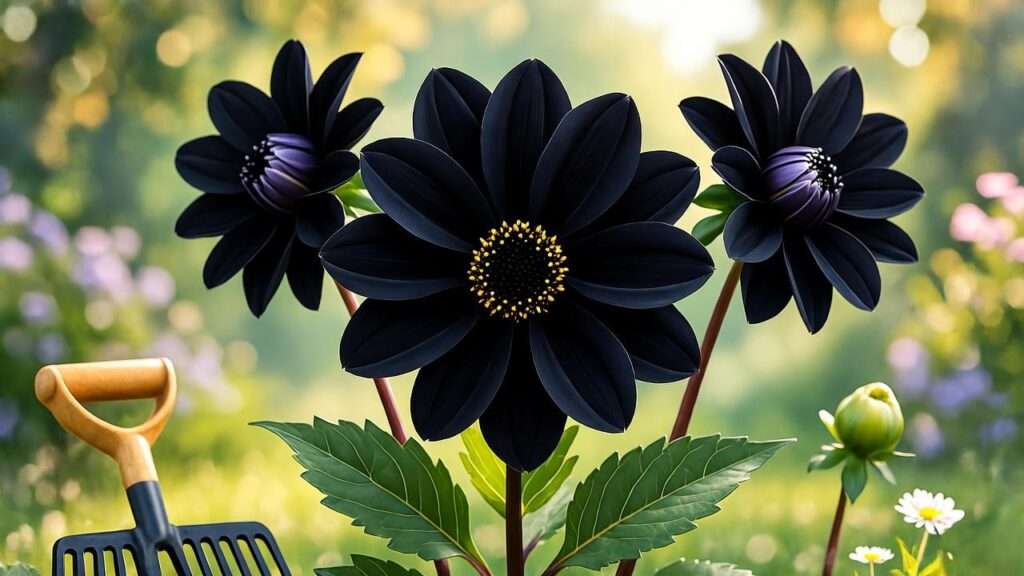Imagine a garden where deep, velvety blooms steal the show, turning heads with their mysterious allure. The black dahlia plant, with its near-black, burgundy, or dark purple petals, is a true standout, offering unmatched drama and elegance. Whether you’re a novice gardener or a seasoned horticulturist, mastering black dahlia plant care unlocks a world of vibrant, show-stopping flowers. In this comprehensive guide, we’ll dive into everything you need to know to grow and maintain these captivating blooms. From planting tips to pest control, expect expert insights drawn from years of gardening experience to help you achieve a thriving garden. Let’s get started! 🌺
1. Understanding the Black Dahlia Plant 🌿
1.1 What Is a Black Dahlia Plant? 🌺
The black dahlia plant, a striking member of the Dahlia genus, is celebrated for its rich, dark-hued flowers that range from deep burgundy to near-black. Native to Mexico and Central America, dahlias have been hybridized extensively, with black dahlias like ‘Black Jack’ and ‘Arabian Night’ becoming favorites for their bold aesthetic. These perennials (or tender perennials in colder climates) bloom from mid-summer to frost, offering months of visual impact. Their cultural significance, tied to elegance and even mystery (thanks to their name’s association with a famous unsolved case), makes them a conversation starter in any garden.
1.2 Why Choose a Black Dahlia for Your Garden? 🌟
Black dahlias are more than just flowers—they’re a statement. Their unique color palette adds sophistication to borders, containers, or cut flower arrangements. These plants bloom prolifically, often producing dozens of flowers per season, making them ideal for gardeners seeking high-impact results. They’re versatile, thriving in various garden styles, from modern minimalist to gothic-inspired designs. For floral enthusiasts, black dahlias pair beautifully with lighter blooms, creating stunning contrasts. Plus, their long blooming season ensures your garden stays vibrant from summer through fall, delighting both you and your visitors.
2. Ideal Growing Conditions for Black Dahlia Plants ☀️
2.1 Climate and Hardiness Zones 🌎
Black dahlias thrive in USDA hardiness zones 8–11, where they can be grown as perennials. In colder zones (3–7), they’re treated as annuals or dug up and stored over winter. They prefer mild temperatures, ideally between 60–70°F, and are sensitive to frost. In hot climates, provide afternoon shade to prevent scorching. For gardeners in colder regions, starting tubers indoors 4–6 weeks before the last frost can extend the growing season, ensuring vibrant blooms by summer.
2.2 Soil Requirements 🏞️
Healthy black dahlias start with the right soil. They prefer well-draining, fertile loam with a pH of 6.5–7.0. To prepare your soil, mix in organic matter like compost or aged manure to boost fertility and improve drainage. Avoid heavy clay soils, which can cause root rot. A simple percolation test—digging a hole, filling it with water, and checking drainage speed—can confirm if your soil is suitable. If drainage is slow, consider raised beds or adding sand and organic matter to improve conditions.
2.3 Sunlight Needs ☀️
Black dahlias crave full sun, requiring 6–8 hours of direct sunlight daily for optimal blooming. In partial shade, they may produce fewer or smaller flowers, though some afternoon shade in hot climates can prevent petal fading. Position your plants in a south-facing spot for maximum light exposure. If you’re limited to shadier areas, supplement with grow lights for indoor starts or choose a site with dappled sunlight, but expect slightly reduced bloom quality.
3. Planting Your Black Dahlia Plant 🌱
3.1 When to Plant Black Dahlias 📅
Timing is critical for black dahlia success. Plant tubers in spring after the last frost, typically April or May in most regions. In warmer climates (zones 8–11), early fall planting is also viable for next-season blooms. Check your local frost dates to ensure safe planting. For colder regions, starting tubers indoors in pots can give plants a head start, allowing you to transplant them outdoors once temperatures stabilize.
3.2 How to Plant Black Dahlia Tubers 🌾
- Select Healthy Tubers: Choose firm, plump tubers with at least one “eye” or growth bud. Avoid soft or shriveled ones.
- Prepare the Site: Dig holes 6–8 inches deep, spaced 18–24 inches apart to allow for growth.
- Plant Properly: Place tubers horizontally with the eye facing up, covering with 2–3 inches of soil initially. Gradually fill the hole as sprouts emerge.
- Water Thoroughly: Water deeply after planting to settle the soil, but avoid waterlogging.
A well-planted tuber can sprout within 2–4 weeks, setting the stage for robust growth.
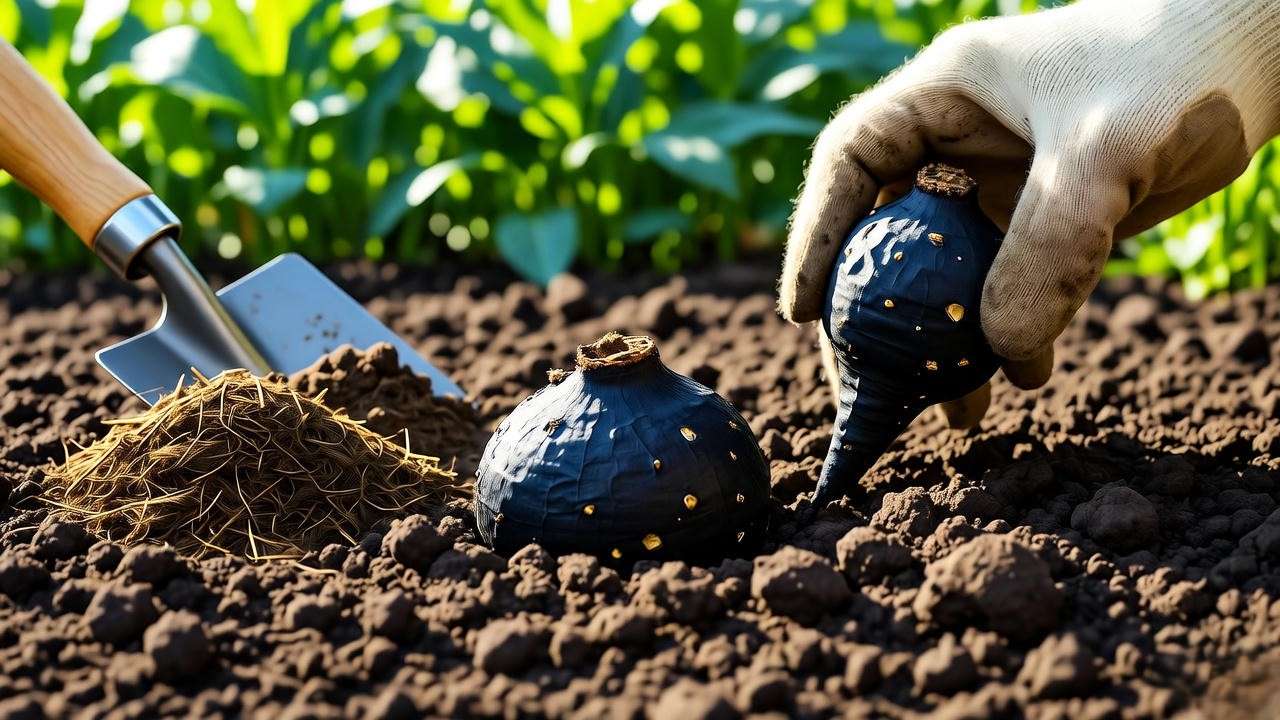
3.3 Starting from Seeds or Cuttings 🌿
While tubers are the most common method, black dahlias can also be grown from seeds or cuttings. Seeds take longer, requiring 6–8 weeks of germination and another season to reach full bloom size, but they’re ideal for experimenting with new varieties. Cuttings, taken from healthy shoots in spring, root quickly in moist, sterile soil and can produce blooms in the same season. Both methods require patience but offer rewarding results for dedicated gardeners.
4. Caring for Your Black Dahlia Plant 🌼
4.1 Watering Needs 💧
Black dahlias need consistent moisture, especially during active growth and blooming. Water deeply once or twice a week, ensuring the soil stays moist but not soggy. Overwatering can lead to root rot, while underwatering may cause wilting or fewer blooms. Check soil moisture by inserting a finger 2 inches deep—if it’s dry, water thoroughly. In hot weather, increase frequency but ensure proper drainage. Mulching with organic material like bark can help retain moisture and regulate soil temperature.
4.2 Fertilizing for Vibrant Blooms 🌸
To fuel those stunning blooms, fertilize black dahlias monthly during the growing season with a balanced 10-10-10 fertilizer or a low-nitrogen formula (e.g., 5-10-10) to prioritize flowers over foliage. Organic options like compost tea or fish emulsion work well for eco-conscious gardeners. Apply fertilizer around the plant’s base, avoiding direct contact with stems. Over-fertilizing can lead to lush leaves but fewer blooms, so follow package instructions carefully. A soil test can pinpoint nutrient deficiencies for tailored feeding.
4.3 Staking and Supporting Tall Stems 🌿
Black dahlias often grow 3–5 feet tall, with heavy blooms that can snap stems in wind or rain. Staking is essential to keep plants upright. Use sturdy bamboo stakes or metal cages, securing stems with soft ties to avoid damage. Install supports at planting time to prevent root disturbance later. For a DIY approach, create a grid with stakes and twine for multiple plants. Check supports weekly, adjusting as the plant grows to ensure stability.
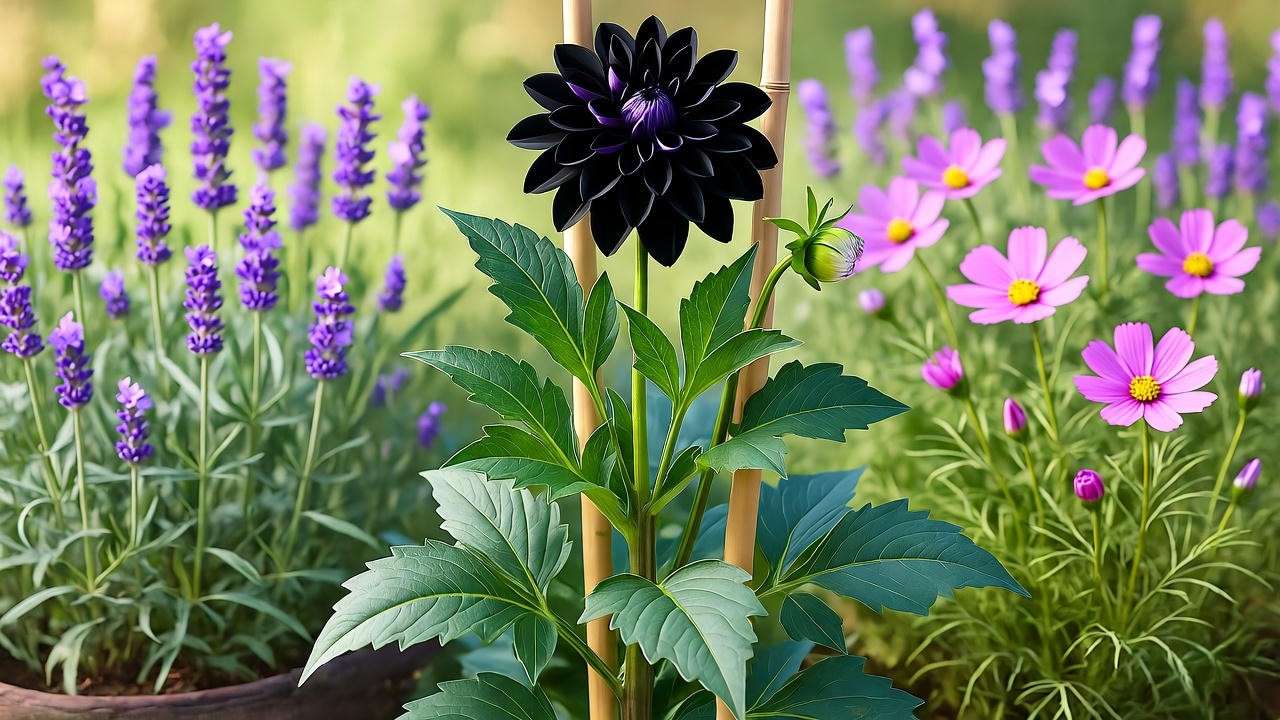
4.4 Pruning and Deadheading ✂️
Deadheading—removing spent blooms—encourages continuous flowering and keeps plants tidy. Snip faded flowers just above a leaf node using clean, sharp shears. For bushier growth, pinch back the main stem when it reaches 12–18 inches tall, promoting side shoots. Regular pruning also improves air circulation, reducing disease risk. Dispose of pruned material to prevent pests or fungal spread. Consistent deadheading can extend the blooming season well into fall.
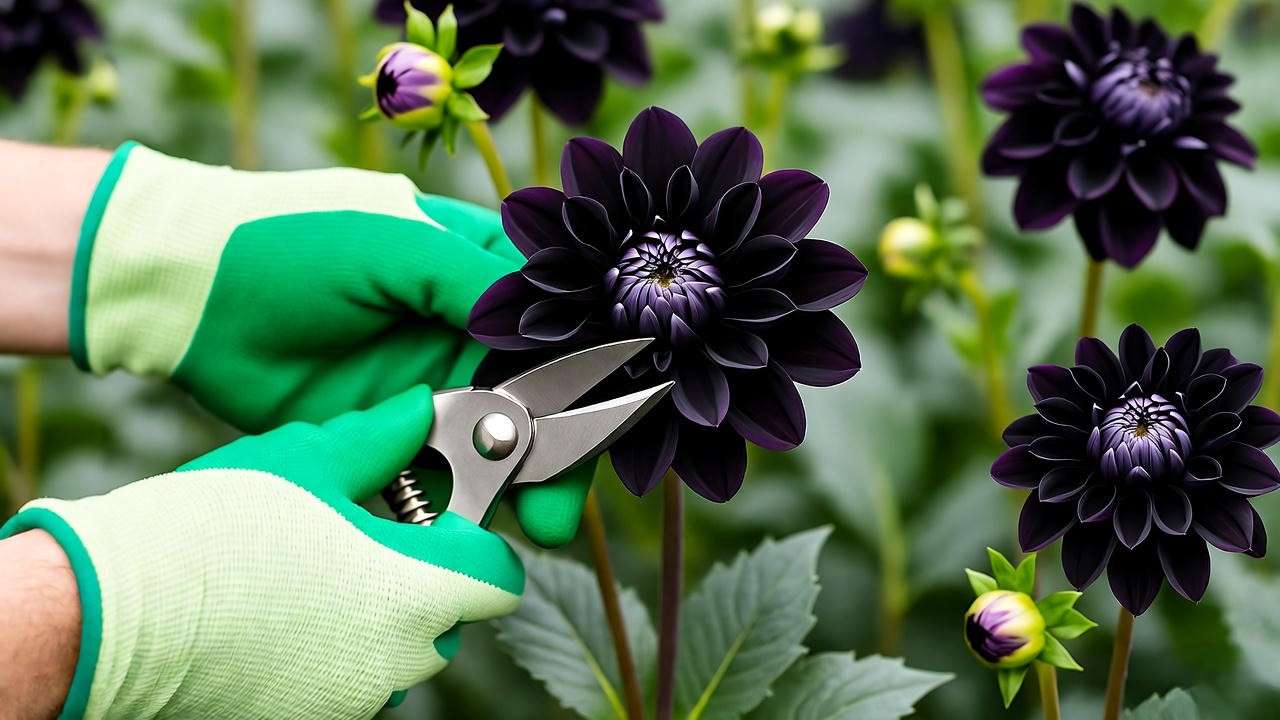
5. Common Pests and Diseases 🐞
5.1 Identifying Pests 🕷️
Black dahlias attract pests like aphids, spider mites, and slugs. Aphids cluster on new growth, sucking sap and weakening plants. Spider mites cause stippled leaves, thriving in hot, dry conditions. Slugs chew irregular holes in leaves and blooms. Control pests with neem oil, insecticidal soap, or hand-picking for slugs. Companion planting with marigolds or garlic can deter pests naturally. Regular inspections, especially under leaves, catch infestations early.
5.2 Managing Diseases 🦠
Fungal diseases like powdery mildew (white coating on leaves) and root rot (caused by poor drainage) can affect black dahlias. Botrytis, or gray mold, may appear in humid conditions, causing flower rot. Prevent diseases by spacing plants 18–24 inches apart for air circulation and ensuring well-draining soil. Treat powdery mildew with a baking soda spray (1 tsp per quart of water) or approved fungicides. Remove and destroy affected plant parts to stop spread.
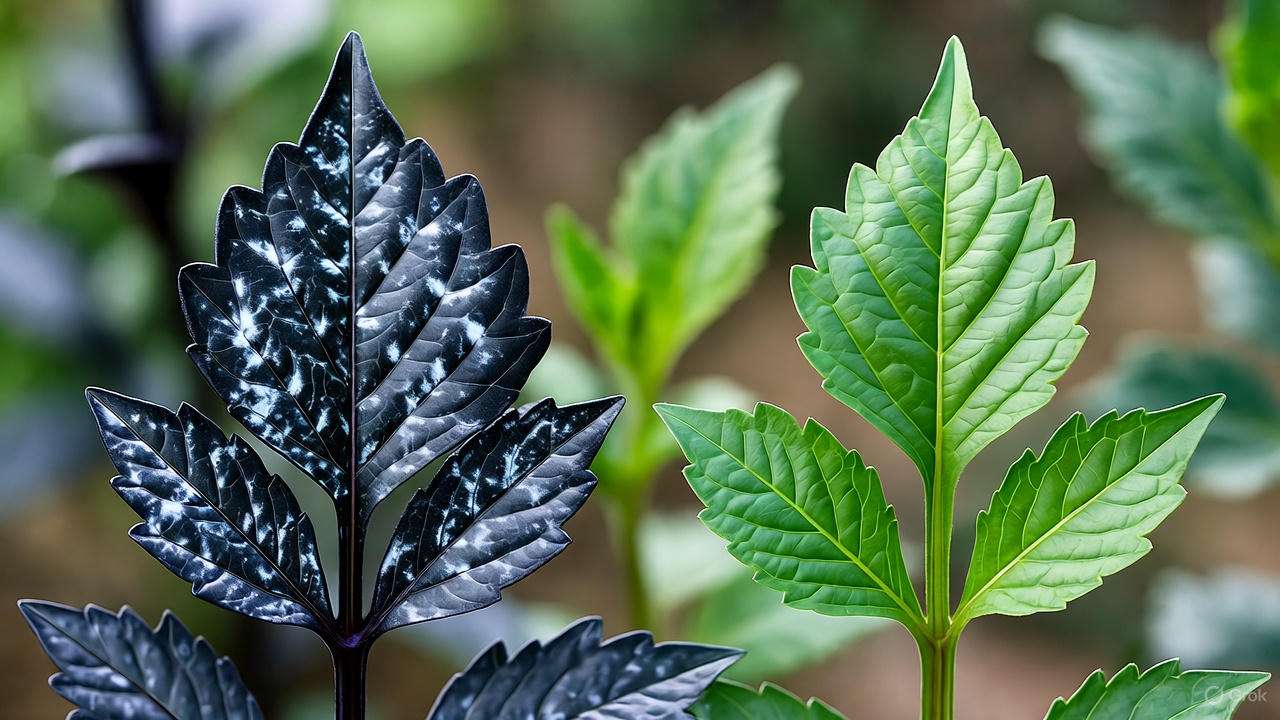
6. Overwintering Black Dahlias in Cold Climates ❄️
6.1 Digging and Storing Tubers 🧤
In colder climates (USDA zones 3–7), black dahlias cannot survive winter outdoors. To overwinter them, dig up tubers after the first frost when foliage turns black. Follow these steps:
- Cut Back Foliage: Trim stems to 4–6 inches above ground using clean, sharp shears.
- Dig Carefully: Use a garden fork to lift tubers, working 12 inches from the stem to avoid damage.
- Clean and Dry: Gently shake off excess soil and let tubers air-dry in a shaded, dry area for 1–2 days.
- Store Properly: Place tubers in a box with peat moss, vermiculite, or sawdust, ensuring they don’t touch. Store in a cool (40–50°F), dark, dry place, checking monthly for rot or shriveling.
Common mistakes include storing wet tubers (which invites mold) or exposing them to freezing temperatures. Label tubers by variety to track your favorites for replanting.
6.2 Alternatives for Warmer Climates 🌞
In milder zones (8–11), black dahlias can remain in the ground year-round with proper care. Apply a 4–6 inch layer of organic mulch, such as straw or bark, to insulate roots against unexpected cold snaps. Ensure soil remains well-draining to prevent rot during wet winters. If temperatures dip below 20°F, consider adding a frost blanket for extra protection. Check plants in early spring for new growth, removing mulch gradually as temperatures rise.
7. Design Ideas for Black Dahlias in Your Garden 🌺
7.1 Companion Plants 🌼
Black dahlias shine when paired with complementary plants that enhance their dark allure. White cosmos or baby’s breath create a striking contrast, while lavender or salvia adds soft purple tones for harmony. Silver foliage plants, like dusty miller or lamb’s ear, amplify the gothic elegance of black dahlias. For a bold look, combine with vibrant reds or oranges, such as zinnias or marigolds. Space companions 12–18 inches away to avoid competition, and consider bloom times to ensure a cohesive display throughout the season.
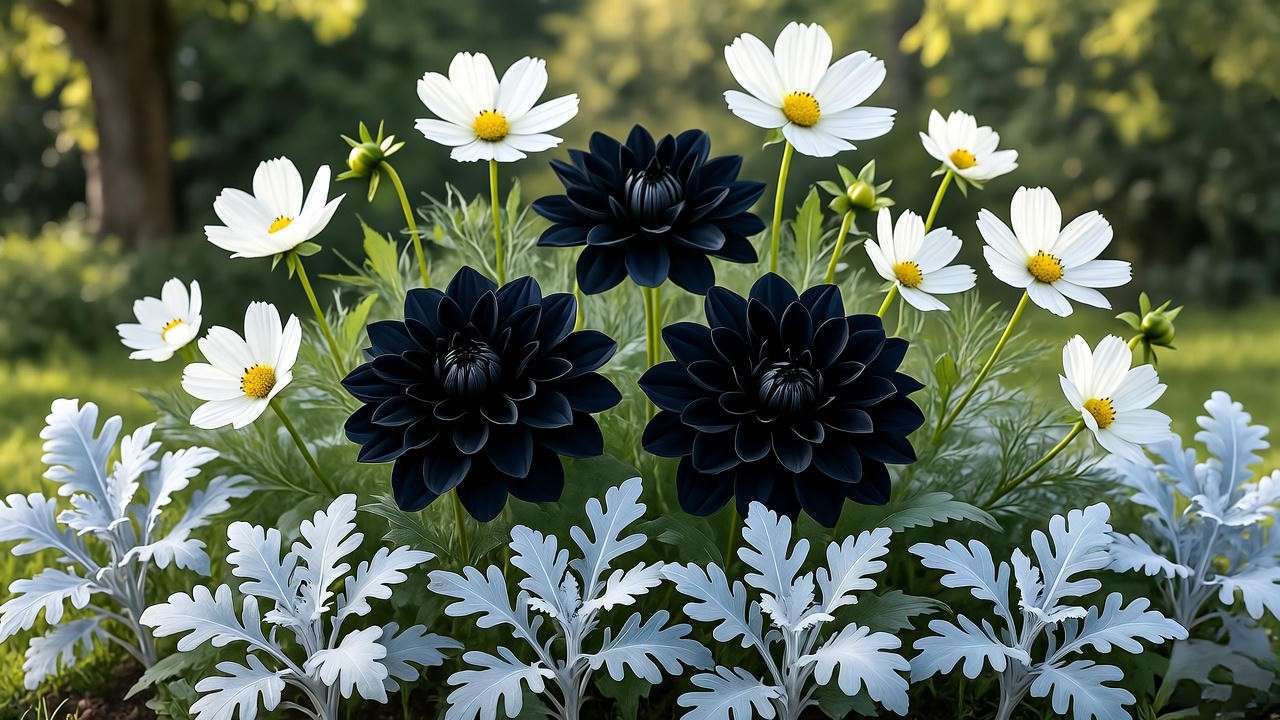
7.2 Using Black Dahlias in Containers 🪴
Black dahlias thrive in containers, making them perfect for patios or small spaces. Choose pots at least 12–15 inches deep and wide with drainage holes. Use a mix of potting soil, compost, and perlite for optimal drainage and fertility. Place containers in full sun, and water more frequently than in-ground plants, as pots dry out faster. Add a small stake or cage at planting to support stems. Containers allow flexibility to move plants indoors during early frosts, extending the blooming season.
7.3 Incorporating into Cut Flower Arrangements 💐
Black dahlias make breathtaking additions to bouquets, with blooms lasting up to a week in a vase. Cut stems early in the morning when flowers are half-open, using sharp shears to make a diagonal cut. Remove lower leaves to prevent rot in water, and place in a vase with lukewarm water and floral preservative. Pair with white roses, eucalyptus, or ferns for elegant arrangements. Change water every 2 days and recut stems to maintain freshness. For a dramatic centerpiece, cluster multiple black dahlia blooms with minimal greenery.
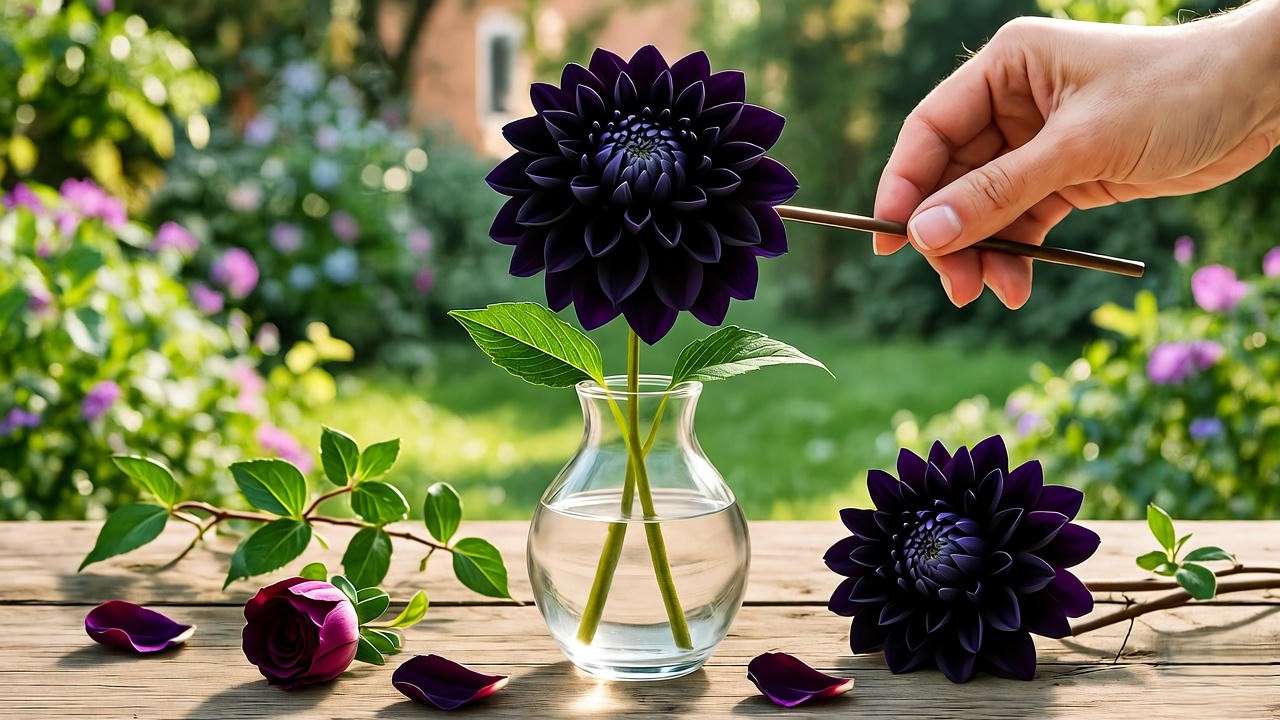
8. Troubleshooting Common Black Dahlia Problems 🛠️
8.1 Why Aren’t My Black Dahlias Blooming? 🌸
If your black dahlias aren’t flowering, consider these culprits:
- Insufficient Sunlight: Less than 6 hours of direct sun reduces blooms. Relocate plants or trim overhanging branches.
- Poor Soil Nutrition: Low phosphorus or potassium can stunt flowering. Test soil and apply a bloom-boosting fertilizer (e.g., 5-10-10).
- Improper Planting Depth: Tubers planted too deep may focus energy on roots. Ensure eyes are 2–3 inches below soil.
Monitor plants for a week after adjustments to assess improvement, and consult a local extension service for region-specific advice.
8.2 Dealing with Weak or Leggy Plants 🌿
Leggy or weak black dahlias often result from overcrowding, insufficient support, or nutrient imbalances. Thin plants to ensure 18–24 inches of spacing for air circulation and light access. Add stakes or cages if not already in place. Over-fertilization with high-nitrogen formulas can cause excessive foliage growth; switch to a low-nitrogen fertilizer. Pinching back stems early in the season promotes bushier, sturdier plants. Regular monitoring and early intervention can prevent long-term damage.
9. Expert Tips for Next-Level Black Dahlia Care 🌟
- Pinching for Bushier Plants: When plants reach 12–18 inches, pinch off the top 3–4 inches of the main stem to encourage side shoots, resulting in more blooms.
- Dividing Tubers: Every 2–3 years, divide tubers in spring to maintain vigor. Cut sections with at least one eye, and replant or share with fellow gardeners.
- Seasonal Care Calendar:
- Spring: Plant tubers, start fertilizing, and set up stakes.
- Summer: Water consistently, deadhead, and monitor for pests.
- Fall: Reduce watering as blooming slows; dig tubers after frost.
- Winter: Store tubers or mulch in-ground plants in mild climates.
- Horticulturist’s Advice: According to the American Dahlia Society, maintaining consistent soil moisture and avoiding overhead watering significantly boosts bloom size and color intensity. Experiment with hybrid varieties for unique shades and forms.
10. FAQs About Black Dahlia Plant Care ❓
- Q1: How long do black dahlias bloom?
Answer: With proper care, black dahlias bloom from mid-summer to the first frost, often 3–4 months, depending on your climate. - Q2: Can black dahlias grow in shade?
Answer: They prefer full sun but can tolerate partial shade with reduced blooms. Aim for at least 4–6 hours of sunlight. - Q3: Are black dahlias toxic to pets?
Answer: Dahlias are mildly toxic to cats and dogs, causing stomach upset if ingested. Keep plants out of reach of curious pets. - Q4: How often should I divide black dahlia tubers?
Answer: Divide every 2–3 years to prevent overcrowding and maintain healthy growth. - Q5: Why are my black dahlia leaves turning yellow?
Answer: Yellowing leaves may indicate overwatering, nutrient deficiency, or pests. Check soil moisture and inspect for aphids or spider mites.
Conclusion 🌷
Growing a stunning black dahlia plant is a rewarding journey that transforms your garden into a showcase of elegance and drama. By following this guide—planting in well-draining soil, providing ample sunlight, and maintaining consistent care—you’ll enjoy vibrant, velvety blooms all season long. Whether you’re troubleshooting pests, overwintering tubers, or designing a gothic-inspired garden, these expert tips ensure success. Share your black dahlia photos on social media or drop questions in the comments for personalized advice. Explore more plant care guides on our site, and let your garden bloom with confidence! 🌺

